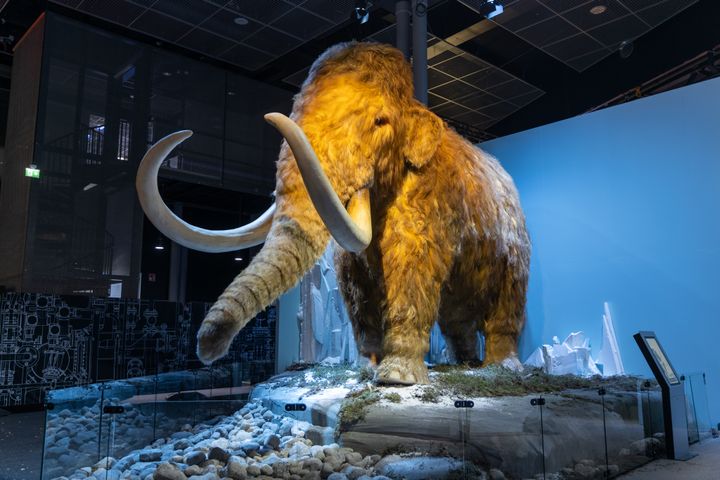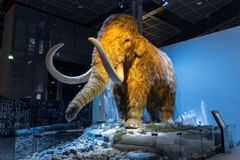The animals and nature of the Ice Age come to life in Heureka’s new exhibition
Science Centre Heureka’s new Giants of the Ice Age exhibition takes you towards the end of the last Ice Age some 14,000 years ago. Back then, the natural world was dominated by large mammals such as woolly mammoths, woolly rhinos and sabre-toothed cats, with whom humans coexisted.

In the exhibition, visitors encounter life-sized robotic Ice Age animals and learn about the natural environment of four geographical areas during that time. The multisensory exhibition experience offers a glimpse into life in Finland, Europe and Eurasia, and North and South America during the last Ice Age. Some 14,000 years ago, modern humans had already populated every continent except Antarctica.
At the start of the exhibition, on the edge of an ice sheet, is a giant woolly mammoth (Mammuthus primigenius) standing over four metres tall. During the last Ice Age, the area of present-day Finland were covered by a continental ice sheet up to two kilometres thick. At times, however, the glaciers retreated, and parts of Finland were revealed. During the Ice Age, mammoths inhabited a vast area stretching from Spain through Europe and Russia all the way to China. A small number of mammoth bones and teeth have also been found in Finland. The youngest of these is a shoulder bone (humerus), approximately 15,500 years old, discovered in Helsinki’s Herttoniemi.
In addition to the woolly mammoth, the exhibition includes a woolly rhinoceros, a polar bear and a cave lion in the area depicting the mammoth steppe of Western Europe. In the Californian redwood forest, visitors meet a short-faced bear, a mastodon and a dire wolf. The exhibition area representing the Pampas Plains in Argentine includes some of the animals specific to that region, such as the giant ground sloth, the hippidion, the toxodon and the ferocious sabre-toothed cat.
Visitors can immerse themselves in the lives of Ice Age humans by creating cave paintings, exploring an Ice Age dwelling and wearing clothes commonly worn during the Ice Age. In the exhibition, you can also step into a cave and learn about musical instruments used during the Ice Age, such as a drum, a flute, a rattle and a bullroarer.
- The Ice Age world was very different from the world we live in now. During the Ice Age, nature was dominated by large mammals that coexisted with humans for a short time. Throughout the world’s history, the changing climate has had dramatic effects on nature. The current state of the natural world is extraordinary by the standards of Earth’s history. There are fewer large wild animals in the world than there have been in many millions of years. A significant part of the megafauna, meaning animals weighing more than 45 kg, became extinct at the end of the last Ice Age. This makes all current animal species survivors, says biologist Maija Karala, who served as a scientific expert for the exhibition.
At the end of the Ice Age, nature had to simultaneously adapt to a changing climate and humans. As a result, about two thirds of the world’s large animals went extinct. Now nature is at the mercy of humans again. We are changing the climate faster and making it hotter than in millions of years. Greenhouse gases prevent the Sun’s heat escaping into space, and humans are now releasing more greenhouse gases into the atmosphere than the amount that escapes. The actions of humans will determine how much warmer the climate will still become.
Today, we have a better understanding of our impact on the survival of both our own species and other species, and we can act in a more sustainable way if we want. The exhibition is a story about biodiversity, and how humans have the opportunity to influence its preservation.
The Giants of the Ice Age exhibition will be on display at Heureka from 8 February 2025 to 6 September 2026.
More information:
Exhibition Project Manager Päivi Garner, tel. +358 40 9015 271, paivi.garner@heureka.fi
Exhibition website: https://www.heureka.fi/en/blogs/exhibitions/giants-of-the-ice-age
Keywords
Contacts
Exhibition Project Manager Päivi Garner, tel. +358 40 9015 271, paivi.garner@heureka.fi
Images

Links
Heureka, the Finnish Science Centre, is a lively hands-on exhibition and activity centre for all ages and among Finland’s most popular leisure time destinations. Heureka opened to the public on April 28, 1989 and attracts nowadays on the average 300 000 visitors a year. Heureka is located in the Helsinki metropolitan area, in city of Vantaa, Tikkurila, and it is open around the year.
Subscribe to releases from Tiedekeskus Heureka
Subscribe to all the latest releases from Tiedekeskus Heureka by registering your e-mail address below. You can unsubscribe at any time.
Latest releases from Tiedekeskus Heureka
Heurekan uudistettu planetaario avautuu joulun välipäiviksi2.12.2025 11:35:12 EET | Tiedote
Median edustajat ovat tervetulleita tutustumaan ennakkoon uudistettuun planetaarioon tiistaina 16.12.2025 klo 8.30–10.00. Ilmoittautuminen 12.12. mennessä os. media@heureka.fi Heurekan planetaario avautuu yli vuoden kestäneen täydellisen uudistuksen jälkeen tapaninpäivänä 26.12.2025. Planetaario on kokenut historiansa suurimman muodonmuutoksen. Sen sisätilat, projisointikupu ja esitystekniikka on uudistettu vastaamaan nykypäivän odotuksia ja standardeja. Heurekan planetaario on nyt yksi Euroopan kirkkaimmista, värikylläisimmistä ja yksityiskohtaisimmista esitysympäristöistä.
Avaruusfaneille mieluisaa ohjelmaa Heurekan perhetapahtumassa18.11.2025 07:26:05 EET | Tiedote
Heurekassa järjestetään Huikea avaruus! -perhetapahtuma lauantaina 29.11. kello 10–18. Tapahtumassa opitaan avaruudesta innostavien ohjelmien ja työpajojen kautta.
Tutkimuksen mukaan Heureka vapaa-ajankeskusten ykkönen28.10.2025 10:57:36 EET | Tiedote
Tiedekeskus Heureka saavutti ykkössijan lukuisilla mittareilla Taloustutkimuksen vuosittaisessa Vapaa-ajankeskusten imagot 2025 -tutkimuksessa. Heureka oli kärkisijalla niin vastaajien antamien yleisarvosanojen, mielikuvatekijöiden yhteisvaikutuksen kuin suosittelutodennäköisyydenkin perusteella kaikista 30 tutkimuksessa mukana olleesta kotimaisesta vapaa-ajankeskuksesta.
Vesi virtaa Heurekan uudessa näyttelyssä 30.10.2025 alkaen22.10.2025 13:19:21 EEST | Tiedote
Heurekan uusi Vesi – elämän virta -näyttely vie veden kiehtovaan maailmaan. Näyttely havainnollistaa makean veden kiertokulkua ja ihmisen osallisuutta siinä.
Halloween-tapahtumat Heurekassa ammentavat teemansa uudesta vesiaiheisesta näyttelystä16.10.2025 08:33:12 EEST | Tiedote
Loka-marraskuun vaihteessa Heurekassa juhlitaan Halloweenia perjantai-iltana 31.10. aikuisten kesken ja lauantaina 1.11. koko perheen voimin Lasten Halloweenissa. Halloween-tapahtumia vietetään viemäriteemalla torstaina 30.10. avautuvan Vesi – elämän virta -näyttelyn kunniaksi.
In our pressroom you can read all our latest releases, find our press contacts, images, documents and other relevant information about us.
Visit our pressroom